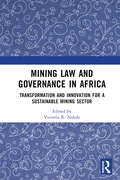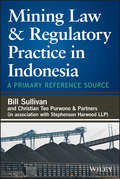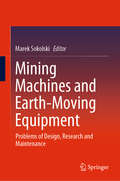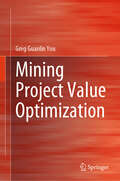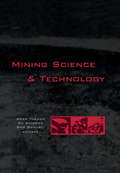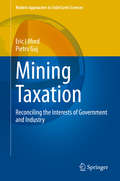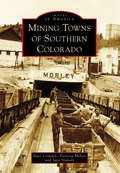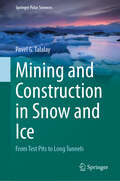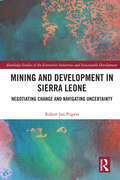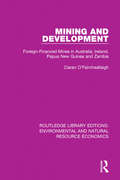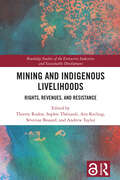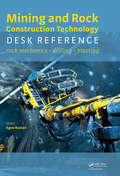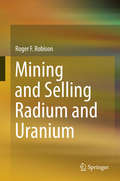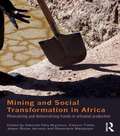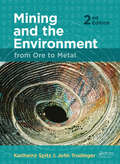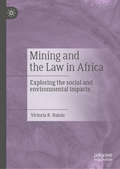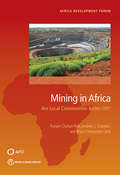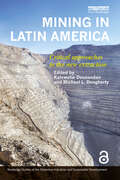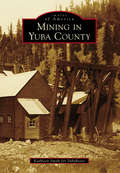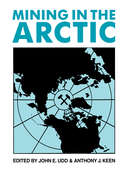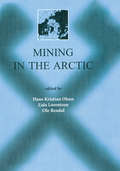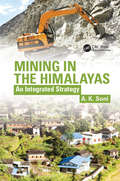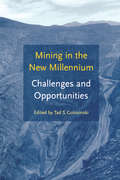- Table View
- List View
Mining Law and Governance in Africa: Transformation and Innovation for a Sustainable Mining Sector
by Victoria R. NaluleThis book explores the various issues that characterise the African mining sector, drawing examples from different African countries and regional organisations. Although there is a massive literature on the subject, some issues have been neglected, including the crucial role of digitalisation and technological advancement in resolving the environmental and social challenges faced in Artisanal and Small-Scale Mining (ASM), deep-sea mining, mining contract negotiations and modernising mining laws to reflect the increasing role of critical minerals, to mention but a few. Therefore, the book unpacks the critical issues associated with the mining sector, explicitly reflecting on the practical solutions needed to address the challenges in the African mining sector. This book uniquely analyses and adds flavour to international mining’s fundamental concepts by describing a simulated annealing-based approach appropriate for complex mining projects in Africa. Book contributors comprise of academics from different universities including professors, practitioners, government policymakers, NGO executives and a variety of different experts. This multidisciplinary book will be of interest to African policymakers, governments, academics, industry professionals, energy and mining institutions, international organisations, universities across the globe and companies.
Mining Law and Regulatory Practice in Indonesia
by William A. Sullivan Christian Teo Purwono PartnersThe first and only English-language reference to the laws and regulations of the booming Indonesian mining sector As the growing Indonesian mining industry attracts new investment from foreign mining companies, those companies are faced with the daunting challenge of unraveling the hugely confusing and complex plethora of local laws and regulations that govern the industry. Until now, there has been no comprehensive English-language guide to Indonesia's mining laws that western companies could turn to for reliable guidance and advice. This detailed reference fills that gap for the mining companies, advisors, and consultants who must navigate this confusing and growing web of regulation on a daily basis. The only English-language reference on the subject of Indonesian mining law A valuable guide for anyone in the mining industry currently doing business or intending to do business in Indonesia Written by a highly regarded legal expert with deep experience in the Indonesian mining industry Combines all the relevant regulations in one comprehensive guide Ideal for professionals in the mining industry, as well as academics, government institutions, policy makers, and industry associations, Mining Law & Regulatory Practice in Indonesia is the perfect guide for an underserved market.
Mining Machines and Earth-Moving Equipment: Problems of Design, Research and Maintenance
by Marek SokolskiThis book presents central problems in the design, research and maintenance of large-size mining machines for open pits, mobile earth-moving machinery, hydraulic hammers for mining and civil engineering, and screening processes for bulk materials. It brings together the insights of numerous respected academics to offer a thorough and multifaceted overview of the topic. The first few chapters of the book deal with specific problems that frequently occur in machinery for open-pit mining. They focus on the resilience of large-size mining machines, degradation of steels used for supporting structures, and modelling of large-size rotary joints, as well as the noise hazards in connection with degradation processes. The book then moves on to discuss problems arising in earth-moving machinery, such as new approaches to the assessment of operation and maintenance, dynamic loads in front-end loader booms, and synchronic transfer of power from the engine to the driven wheels. The book concludes by discussing hydraulic hammers for mining and civil engineering, and screening processes for bulk materials that combine a vibroscreen with additional feed elements. The book is primarily intended for undergraduate and graduate mechanical engineering courses, but will also be of interest to researchers and mechanical engineers.
Mining Project Value Optimization
by Greg Guanlin YouThis book provides a holistic approach of integrated mine planning and scheduling to optimize mining projects using the discounted cash flow rate of return (DCF-ROR) method. There are nine chapters in the book. Chapter 1 is the Introduction, which provides overviews of mineral assets, minerals in Australia, mineral exploration, mining methods, and significance of valuation, optimization, and integrated mine planning. Chapter 2 is the Mineral Resources and Ore Reserves Estimation, including grade composition method, inverse distance weighting method, ordinary Kriging method and block model. Chapter 3 is the Feasibility Study that delves into three phased feasibility study, namely scoping, prefeasibility and feasibility studies, data requirements, risk identification and mitigation in the feasibility study, and mining project cost estimation. Chapter 4 is the Valuation of Mineral Projects. It starts with the time value of money; followed by methods to calculate cash flow, discounted cash flow (DCF), net present value (NPV), internal rate of return (IRR) and payback period; valuation methods, including market-, income-, and cost-based approaches; and finally the sensitivity study of key factors influencing the valuation of mining projects. Chapter 5 is the Mine Planning and Open Pit Optimization that covers different types of mine planning, block model valuation, Lerchs-Grossmann and floating cone techniques for pit optimization. Chapter 6 is the Life of Mine Optimization that details a case study of strip mining optimization using the DCF-ROR method and integrated LOM optimization of open pit mining. Chapter 7 is the Production Schedule Optimization of Surface Mining, covering production schedule optimization, equipment availability and utilization, and loading and hauling equipment match optimization. Chapter 8 is the Optimization of Underground Mine Planning and Scheduling that delves to a case study of room and pillar mining optimization using the DCF-ROR method and mathematical programs for underground stope layout and production schedule optimization. Chapter 9 is the Conclusion of the book. The book can benefit students and professionals in multiple ways. Firstly, divisions and confusions may arise from different contexts of technical frameworks, taxation, and relevant legislations in literature. Having quality contents in one book will improve the efficiency of study. Secondly, the inclusion of plentiful hands-on examples and calculation tables underscores the practical application of the concepts, bridging the gap between theoretical knowledge and real-world scenarios. Thirdly, the book adopts an integrated approach to evaluate and optimize mineral projects, utilizing methodologies such as DCF-ROR for optimization, ordinary Kriging for ore reserve estimation, and multi-level optimization including strategic planning, pit optimization, life of mine optimization, and production schedule optimization. Finally, the content is fully aligned with internationally recognized standards such as the VALMIN and JORC codes, ensuring compliance with industry best practices and guidelines.
Mining Science and Technology: Proceedings of the 5th International Symposium on Mining Science and Technology, Xuzhou, China 20-22 October 2004
by Yuehan Wang Shirong Ge Guangli GuoJointly sponsored by the China University of Mining and Technology and the University of Nottingham, UK, a total of 187 papers have been included in the proceedings, of which fifty-two are contributed by authors outside of China. Scholars and experts from both China and abroad discuss and exchange information on the latest developments in mining sc
Mining Taxation: Reconciling the Interests of Government and Industry (Modern Approaches in Solid Earth Sciences #18)
by Eric Lilford Pietro GujThis book examines existing mineral fiscal policies covering income taxation, royalties, free carried and participative (community and government) interests and also highlights the impacts of these policies on the feasibility of mineral projects as well as on revenue and other benefits to the State. While publications already exist on the subject matter, they have invariably approached the topic primarily from a Government standpoint rather than the mining industry. This book aims to provide a balance in this debate by comparing the financial outcomes gained or foregone by both Government and industry under different policy regimes. The discussions are supported by quantitative examples to more clearly articulate the potential outcomes and better inform future fiscal policy decisions.
Mining Towns of Southern Colorado
by Victoria Miller Staci Comden Sara SzakalyLesser known than the gold and silver mines of Western lore, Southern Colorado's extensive coal mines fueled the engines for Western industrialization in the late 19th and early 20th centuries. Of the numerous companies operating the mines, the Colorado Fuel and Iron Company (CF&I) was king. With a total of 62 mines, the majority of them in Colorado's Las Animas, Huerfano, and Fremont Counties, CF&I ruled the lives of countless miners in company towns scattered throughout Southern Colorado. Working long hours, often in cramped underground caverns, the workers emerged to families living in lonely mountain landscapes completely provisioned with company homes, stores, schools, and churches. Images of America: Mining Towns of Southern Colorado gives an intimate glimpse into the lives of these pioneer mining families.
Mining and Construction in Snow and Ice: From Test Pits to Long Tunnels (Springer Polar Sciences)
by Pavel G. TalalaySnow, firn, and ice are the most widespread cryogenic minerals on Earth’s surface. Their properties differ significantly from those of common minerals, and their excavation requires special approaches. The problems of mining and construction in snow and ice could be explained mostly by harsh climate conditions, logistics difficulties, environmental issues and snow-ice related challenges. The primary objective of this book is to list all feasible technologies for mining and construction in snow and ice, and to analyze these from the perspective of applications, problems, and hindrances. Although mining and construction in snow and ice appears exotic, it is significantly common for the production of snow and ice as a source of freshwater and construction material; accessing subglacial ore; the investigation and sampling of near-surface layers; glacier geoengineering works; recovering of snow-buried objects; construction of subsurface shelters for living, working, and military facilities; observation and investigation of glacier beds; construction of sightseeing ice tunnels; and drainage of ice-dammed proglacial lakes.
Mining and Development in Sierra Leone: Negotiating Change and Navigating Uncertainty (Routledge Studies of the Extractive Industries and Sustainable Development)
by Robert Jan PijpersMining and Development in Sierra Leone examines how different actors in Sierra Leone use the effects of large-scale mining to navigate and transform the challenging conditions of life. The book offers an in-depth analysis of the processes of development and change that mark resource extraction environments globally. Across the world, resource extraction is assigned an important role in development agendas. Yet a key question is how development opportunities are given shape and accessed and how extraction’s negative impacts are dealt with in actual politics and practices. Set in the Northern Province of Sierra Leone during a global mining boom, this book shows how mining-cum-development’s multifaceted effects materialize. By taking the micro-politics of large-scale mining as its principal focus, the book analyzes a range of the most perplexing phenomena of life in Sierra Leone and scrutinizes the intricate and contentious processes of change unfolding in mining environments. Mining and Development in Sierra Leone goes beyond promise-or-problem dichotomies, offers key insights into the struggle for progress that characterizes the mining-development nexus, and provides innovative understandings of the resourceful ways in which different actors negotiate change and navigate uncertainty. This book will be of interest to students and scholars working on resource extraction, large-scale investments, globalization, and development, as well as to development practitioners, mining professionals, and policymakers.
Mining and Development: Foreign-Financed Mines in Australia, Ireland, Papua New Guinea and Zambia (Routledge Library Editions: Environmental and Natural Resource Economics)
by Ciaran O'FaircheallaighThis book, first published in 1984, examines the economics and political issues raised by foreign investment in mineral development. It is an attempt to identify, as far as possible, what occurs in and between countries when foreign investments are made in mineral development, concentrating on two main themes: on the nature of the transactions which constitute the process of foreign investment on the physical level – money and instruments of credit, objects, information and people as they cross national boundaries – and on the nature of the relationships which are created between foreign investors and governments in the countries where the investments are made. The author argues that the nature of physical transactions plays a crucial role in determining the character of host country-foreign investor relations, and the policies and attitudes adopted by host country authorities exercise an important influence, in turn, on the physical effects of foreign investments. As such, the book constitutes a comprehensive overview of the economic and political factors involved in mining and its development.
Mining and Indigenous Livelihoods: Rights, Revenues, and Resistance (Routledge Studies of the Extractive Industries and Sustainable Development)
by Andrew Taylor Sophie Thériault Thierry Rodon Arn Keeling Séverine BouardThis book maps the encounters between Indigenous Peoples and local communities with mining companies in various postcolonial contexts.Combining comparative and multidisciplinary analysis, the contributors to this volume shine a light on how the mining industry might adapt its practices to the political and legal contexts where they operate. Understanding these processes and how communities respond to these encounters is critical to documenting where and how encounters with mining may benefit or negatively impact Indigenous Peoples. The experiences and reflections shared by Indigenous and non-Indigenous contributors will enhance our understanding of evolving practices and of the different strategies and discourses developed by Indigenous Peoples to deal with mining projects. By mobilizing in-depth fieldwork in five regions—Australia, Canada, Sweden, New Caledonia, and Brazil—this body of work highlights voices often marginalized in mining development studies, including those of Indigenous Peoples and women.This book will be of great interest to students and scholars of mining and the extractive industries, sustainable development, natural resource management, and Indigenous Peoples.The Open Access version of this book, available at http://www.taylorfrancis.com, has been made available under a Creative Commons Attribution-Non Commercial-No Derivatives (CC-BY-NC-ND) 4.0 license.
Mining and Quarrying in the Ancient Andes
by Kevin J. Vaughn Nicholas TripcevichOver the millennia, from stone tools among early foragers to clays to prized metals and mineral pigments used by later groups, mineral resources have had a pronounced role in the Andean world. Archaeologists have used a variety of analytical techniques on the materials that ancient peoples procured from the earth. What these materials all have in common is that they originated in a mine or quarry. Despite their importance, comparative analysis between these archaeological sites and features has been exceptionally rare, and even more so for the Andes. Mining and Quarrying in the Ancient Andes focuses on archaeological research at primary deposits of minerals extracted through mining or quarrying in the Andean region. While mining often begins with an economic need, it has important social, political, and ritual dimensions as well. The contributions in this volume place evidence of primary extraction activities within the larger cultural context in which they occurred. This important contribution to the interdisciplinary literature presents research and analysis on the mining and quarrying of various materials throughout the region and through time. Thus, rather than focusing on one material type or one specific site, Mining and Quarrying in the Ancient Andes incorporates a variety of all the aspects of mining, by focusing on the physical, social, and ritual aspects of procuring materials from the earth in the Andean past.
Mining and Rock Construction Technology Desk Reference: Rock Mechanics, Drilling & Blasting
by Agne RustanA comprehensive and illustrated desk reference with terms, definitions, explanations, abbreviations, trade names, quantifications, units and symbols used in rock mechanics, drilling and blasting. Now including rock mechanics as well, this updated edition presents 5127 terms, 637 symbols, 507 references, 236 acronyms, 108 formulas, 68 figures, 47 ta
Mining and Selling Radium and Uranium
by Roger F. RobisonPresented here is the story of the mining and sale of uranium and radium ore through biographical vignettes, chemistry, physics, geology, geography, occupational health, medical utilization, environmental safety and industrial history. Included are the people and places involved over the course of over 90 years of interconnected mining and sale of radium and uranium, finally ending in 1991 with the abandonment of radium paint and medical devices, Soviet nuclear parity, and the Radiation Exposure Compensation Act.
Mining and Social Transformation in Africa: Mineralizing and Democratizing Trends in Artisanal Production (Routledge Studies in Development and Society)
by Deborah Fahy Bryceson Eleanor Fisher Jesper Bosse Jønsson Rosemarie MwaipopoAfter more than three decades of economic malaise, many African countries are experiencing an upsurge in their economic fortunes linked to the booming international market for minerals. Spurred by the shrinking viability of peasant agriculture, rural dwellers have been engaged in a massive search for alternative livelihoods, one of the most lucrative being artisanal mining. While an expanding literature has documented the economic expansion of artisanal mining, this book is the first to probe its societal impact, demonstrating that artisanal mining has the potential to be far more democratic and emancipating than preceding modes. Delineating the paradoxes of artisanal miners working alongside the expansion of large-scale mining investment in Africa, Mining and Social Transformation in Africa concentrates on the Tanzanian experience. Written by authors with fresh research insights, focus is placed on how artisanal mining is configured in relation to local, regional and national mining investments and social class differentiation. The work lives and associated lifestyles of miners and residents of mining settlements are brought to the fore, asking where this historical interlude is taking them and their communities in the future. The question of value transfers out of the artisanal mining sector, value capture by elites and changing configurations of gender, age and class differentiation, all arise.
Mining and Sustainable Development: Current Issues (Routledge Studies of the Extractive Industries and Sustainable Development)
by Sumit. K. LodhiaMining is a transformative activity which has numerous economic, social and environmental impacts. These impacts can be both positive and adverse, enhancing as well as disrupting economies, ecosystems and communities. The extractive industries have been criticised heavily for their adverse impacts and involvement in significant social and environmental scandals. More recently, these industries have sought to respond to negative perceptions and have embraced the core principles of sustainability. This sector could be regarded as a leader in sustainability initiatives, evident from the various developments and frameworks in mining and sustainability that have emerged over time. This book reviews current topical issues in mining and sustainable development. It addresses the changing role of minerals in society, the social acceptance of mining, due diligence in the mining industry, critical and contemporary debates such as mining and indigenous peoples and transit worker accommodation, corporate sustainability matters such as sustainability reporting and taxation, and sustainability solutions through an emphasis on renewable energy and shared-used infrastructure. Written by experts from Australia, Europe and North America, but including examples from both developed and developing countries, the chapters provide a contemporary understanding of sustainability opportunities and challenges in the mining industry. The book will be of interest to practitioners, government and civil society as well as scholars and students with interests in mining and sustainable development.
Mining and the Environment: From Ore to Metal
by Karlheinz Spitz John TrudingerThe history of mining is replete with controversy of which much is related to environmental damage and consequent community outrage. Over recent decades, this has led to increased pressure to improve the environmental and social performance of mining operations, particularly in developing countries. The industry has responded by embracing the ideals of sustainability and corporate social responsibility. Mining and the Environment identifies and discusses the wide range of social and environmental issues pertaining to mining, with particular reference to mining in developing countries, from where many of the project examples and case studies have been selected. Following an introductory overview of pressing issues, the book illustrates how environmental and social impact assessment, such as defined in "The Equator Principles", integrates with the mining lifecycle and how environmental and social management aims to eliminate the negative and accentuate the positive mining impacts. Practical approaches are provided for managing issues ranging from land acquisition and resettlement of Indigenous peoples, to the technical aspects of acid rock drainage and mine waste management. Moreover, thorough analyses of ways and means of sharing non-transitory mining benefits with host communities are presented to allow mining to provide sustainable benefits for the affected communities. This second edition of Mining and the Environment includes new chapters on Health Impact Assessment, Biodiversity and Gender Issues, all of which have become more important since the first edition appeared a decade ago. The wide coverage of issues and the many real-life case studies make this practice-oriented book a reference and key reading. It is intended for environmental consultants, engineers, regulators and operators in the field and for students to use as a course textbook. As much of the matter applies to the extractive industries as a whole, it will also serve environmental professionals in the oil and gas industries. Karlheinz Spitz and John Trudinger both have multiple years of experience in the assessment of mining projects around the world. The combination of their expertise and knowledge about social, economic, and environmental performance of mining and mine waste management has resulted in this in-depth coverage of the requirements for responsible and sustainable mining.
Mining and the Law in Africa: Exploring the social and environmental impacts
by Victoria R. NaluleThe mining sector has been an integral part of economic development in many African countries. Although minerals have been exploited for decades in these countries, the benefits have not always been as visible. This has necessitated reforms including nationalisation of mining activities in the distant past; and currently legal and regulatory reforms. This book gives an insight of these reforms and with reference to the fieldwork research undertaken by the author in some African countries, the book highlights the social and environmental impacts of mining activities in Africa. The central question of the book is, why the mining laws have worked in some countries but not others and what can be done to ensure that these laws are effective? Consequently, the book analyses the legal reforms made in the sector and highlights both the challenges and the opportunities for foreign investors as well as the African governments and local communities. The book will be of great interest to researchers and students in Energy and Geography related fields, as well as to practitioners and policy makers.
Mining in Africa: Are Local Communities Better Off?
by Andrew L. Dabalen Bryan Christopher Land Punam Chuhan-PoleThis study focuses on the local and regional impact of large-scale gold mining in Africa in the context of a mineral boom in the region since 2000. It contributes to filling a gap in the literature on the welfare effects of mineral resources, which, until now, has concentrated more on the national or macroeconomic impacts. Economists have long been intrigued by the paradox that a rich endowment of natural resources may retard economic performance, particularly in the case of mineral-exporting developing countries. Studies of this phenomenon, known as the “resource curse,†? examine the economy-wide consequences of mineral exports.1 Africa’s resource boom has lifted growth, but has been less successful in improving people’s welfare. Yet much of the focus in academic and policy circles has been on appropriate management of the macro-fiscal and governance risks that have historically undermined development outcomes. This study focuses instead on the fortune of local communities where resources are located. It aims to better inform public policy and corporate behavior on the welfare of communities in Africa in which the extraction of resources takes place.
Mining in Latin America: Critical Approaches to the New Extraction (Routledge Studies of the Extractive Industries and Sustainable Development)
by Kalowatie Deonandan Michael L. DoughertyThe last two decades have witnessed a dramatic expansion and intensification of mineral resource exploitation and development across the global south, especially in Latin America. This shift has brought mining more visibly into global public debates and spurred a great deal of controversy and conflict. This volume assembles new scholarship that provides critical perspectives on these issues. The book marshals original, empirical work from leading social scientists in a variety of disciplines to address a range of questions about the practices of mining companies on the ground, the impacts of mining on host communities, and the responses to mining from communities, civil society and states. The book further explores the global and international causes, consequences and innovations of this new era of mining activity in Latin America. Key issues include the role of Canadian mining companies and their investment in the region, and, to a lesser extent, the role of Chinese mining capital. Several chapters take a regional perspective, while others are based on empirical data from specific countries including Bolivia, Brazil, El Salvador, Guatemala and Peru.
Mining in Yuba County
by Yubaroots Kathleen SmithMining in Yuba County illustrates the story of how this geologically unique part of California drew multitudes of people from around the world during the early days of the Gold Rush. It depicts the region's evolution from anarchy to civilization. It gives faces to the individuals who were instrumental in creating society in Yuba. It elaborates on incidents in which Yuba influenced the nation, on matters as historically significant as California entering the Union as a free state and affecting the outcome of the Civil War. Mining in Yuba fostered technological advancement precipitated by the depletion of surface gold and the necessity to get to the obscured gold. Conflicts between miners and agriculturists over hydraulic mining were litigated, and landmark legal decisions regarding the regulation of hydraulic mining all but ended the practice and were the beginnings of environmental protectionism and water rights issues in California. Finally, it reveals that despite heavy regulations that exist today, there is still mining in Yuba County.
Mining in the Arctic
by John E. Udd and A.J. KeenTopics in this international symposium on mining in the arctic included arctic mining in Raglan; analysis and prediction of water infiltration in underground, frozen placer mines; red dog mine-operations update and design of paste tailings disposal in the Russian Sub-Arctic.
Mining in the Arctic: Proceedings of the 6th International Symposium, Nuuk, Greenland, 28-31 May 2001
by Hans Kristian Olsen Lida Lorentzen Ole RendalThe proceedings of the 6th International Symposium on Mining in the Arctic, held in Greenland in 2001. The papers cover a wide variety of topics, including: mining exploration and exploitation; mining engineering and mine design; environmental impact of mining in the Arctic; and more.
Mining in the Himalayas: An Integrated Strategy
by A.K. SoniHimalaya, the world's most prominent mountain system of the world is a source of sustainence for the social, cultural and economic development of population across different countries. Unscientific, small-scale mining for harnessing reounrces including minerals has caused ecosystem damage. Therefore, an integrated and holistic approach to deal with the resource management is required. This book makes a focussed effort to explain how mining in the Himalaya is practiced with discussions pertaining to critiques and lacunas of mining and environmental practices. Status of mining practices in Himalaya is included along with the legal/environmental repercussions of mining.
Mining in the New Millennium - Challenges and Opportunities
by Tad S. GolosinskiThis text concentrates mainly on the Polish mining industry. It involves mining of a significant quantities of lignite, coal, copper, sulphur and many industrial minerals, which are all discussed in this book.
